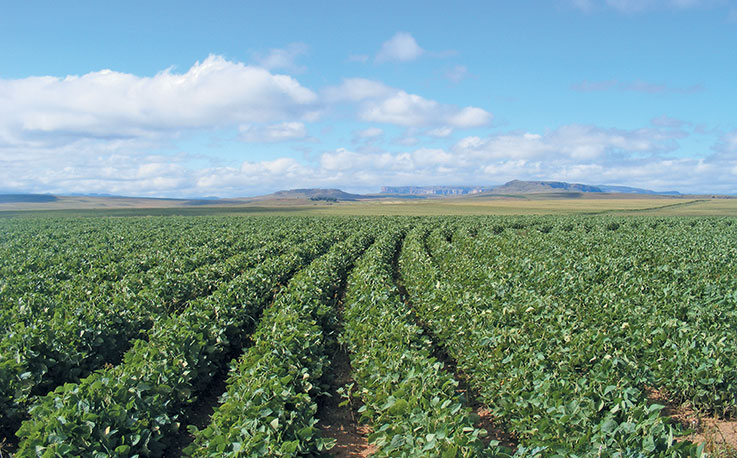
Photo: FW Archive
Nitrogen is one of six macro-elements that a grain crop takes up from the soil. As demand often exceeds supply, the crop usually needs nitrogen-containing fertiliser.
Leguminous crops such as soya bean are an exception; they supplement the soil nitrogen status through a symbiotic nitrogen-fixing process involving Rhizobium bacteria. These penetrate root hairs and live on the energy supplied by photosynthesis in the plant.
In turn, the bacteria fix nearly inert atmospheric nitrogen into compounds needed by the plant.
Because of this symbiosis, nitrogen fertiliser need not be added to soya bean, except on sandy soil where the residual nitrogen level is usually low. If you are growing soya bean on such soil, you can apply a small quantity of nitrogen to enhance the growth of young plants.
The Rhizobium species Bradyrhizobium japonicum is associated with soya bean. This does not occur naturally in South African soil and the soya bean seed (or the soil) must be inoculated with it.
Rotation
The symbiotic nitrogen supply does not end with the soya bean crop. The yield of a maize crop following soya bean is often better than that of maize following maize. The yield increase over years is about 13% in sandy soils.
Maize rotated with soya bean usually shows no nitrogen deficiency, while these often appear in monoculture maize.
More than just nitrogen
It has long been presumed that some symbiotic fixed nitrogen is still available for uptake by a maize crop following a soya bean crop. Closer investigation has shown that this is unlikely.
beanSoya bean is fairly nitrogen neutral, removing roughly the same amount of nitrogen that is fixed. The increase in the residual nitrogen after soya bean is usually too small to explain maize yield improvement.
The yield of soya bean-rotated maize is usually higher than that of monoculture maize irrespective of the amount of nitrogen applied. This shows that factors other than nitrogen are responsible. They include:
- The carry-over of soil moisture from the soya bean to the follow-up maize season;
- An improvement in the soil’s physical properties;
- A decrease in growth- suppressing or an increase in growth-promoting substances;
- A decrease in disease pressure.
A decrease in maize root diseases probably also plays a role. Researchers have found that these diseases occur to a varying extent on nearly all maize plants.
Root rots damage and kills parts of the root system, particularly during the reproductive phase. The root system is thus restricted and moisture and nutritional uptake limited, eventually affecting growth and yield.
Trials have shown that the root system of maize following soya bean, measured after pollination, was 16% larger than that of monoculture maize.
Maize takes up between 20% and 80% of applied fertiliser nitrogen depending on circumstances. The enhanced performance of maize following soya bean is probably due to an increase in nitrogen uptake efficiency through a larger, healthier root system rather than more nitrogen in the soil.
Benefits
Maize can thus benefit in two ways from the preceding soya bean crop: from yield enhancement and from the saving on nitrogen fertiliser.
To take advantage of these benefits, follow a soya bean crop with a non-leguminous crop such as maize rather than another dicotyledonous crop with which it has several diseases in common.
Source: Nel, A. 2016. ‘The nitrogen replacement value of soybean on a following maize crop’. ARC-Grain Crops’











